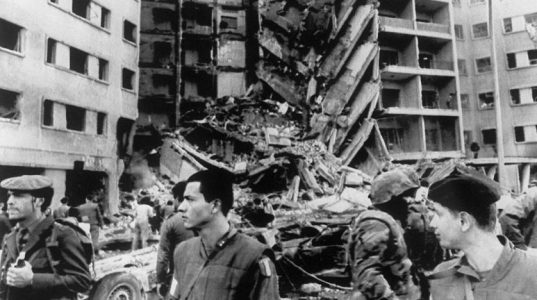
Iran sponsoring terrorist organizations
The escalation of Iran and its Revolutionary Guards Corps (IRGC) in the Middle East has become apparent. It has mobilized the Houthi militias in Yemen to launch attacks against Saudi Arabia through the firing of ballistic missiles and explosives-laden drones. Four commercial vessels were victims of sabotage off the coast of the United Arab Emirates and two Saudi Aramco oil pumping stations were attacked.
Iran’s involvement can be confirmed given that the developments took place as tensions between it and the United States are on the verge of spiraling into a military conflict. On Thursday, the Pentagon outlined proposals to the White House to send military reinforcements to the Middle East to beef up defenses against Iran. This confirms that Iran is pressuring extremist militias to launch attacks against powers that oppose its interests, demonstrating the terrorism it practices in the region.
Being a “state-sponsor of terrorism” means that a country often resorts to systematic violence to create a climate of fear among the people to achieve a certain political goal. A country would also employ terrorism or support terrorist groups as part of its international policy against another country by launching direct or indirect attacks through these groups, which are offered weapons, logistic support, training and even safe haven.
Iran’s terrorism poses a real threat to national or regional security. The international community has recognized this threat and the United States has since 1984 labeled Iran as a state-sponsor of terrorism.
Iran and the Houthis
The IRGC has provided financial and material support, training, weapons and rockets to several terrorist groups, including the Houthis in Yemen. This has allowed the Houthis to fire over 225 ballistic rockets and fly over 145 drones towards Saudi Arabia. They have targeted Saudi government facilities and several cities, including Riyadh.
Saudi-led Arab coalition spokesman Colonel Turki al-Maliki had previously confirmed that inspections of drone shrapnel revealed that they were provided by the IRGC.
Earlier this month, Acting Permanent Representative of the United States to the United Nations Jonathan Cohen said the Houthis must cease UAV attacks against Yemen and their neighbors.
“Iran needs to stop supplying the Houthis with the weapons to do so,” he demanded.
40 years of terror
Countries of the region have suffered from the intransigence of the Iranian regime since the 1979 Khomeini revolution. Tensions between it and the United States have been on the rise since then. They began with the 1979-81 American hostage crisis in Tehran and followed with the policy of “exporting the revolution” and directly or indirectly supporting terrorism. This was demonstrated in the Hezbollah party’s bombing of the American embassy in Beirut in 1983. The Saudi embassy in Tehran was attacked twice, once in 1987 and again in 2016. Iran was behind attempts to disrupt the annual Hajj pilgrimage in Saudi Arabia in 1986 and 1987.
Iran’s behavior has put it at odds with the world. In 2002, then US President George W. Bush said it was part of the “axis of evil” that included North Korea and Iraq. That same year, Iran drew European and American ire over its nuclear ambitions after the People’s Mujahedin of Iran exposed Tehran’s clandestine nuclear program. This year, boiling tensions with Tehran led Washington to designate the IRGC as terrorist. Iran reciprocated by labeling American forces in the region as terrorist.
Safe haven for al-Qaeda
Despite its principle of exporting the revolution and supporting Shiite organizations, Iran has shown some pragmatism by secretly supporting al-Qaeda, a group that stands in stark ideological contrast with Tehran. Seeking its interests, however, has led Iran to cooperate with the terror group. It has harbored several Qaeda operatives on its territories. In turn, the organization has warned its members against attacking Iran.
This was revealed in documents that were discovered by the CIA in Ossama bin Laden’s hideout in Abbottabad in Pakistan in 2011. They unearthed correspondence between bin Laden and another operative in which the Qaeda leader urged him against attacking Iran and holy Shiite sites in Iraq. Bin Laden had also described Iran as a “safe passage for messages, funds and prisoners.”
Correspondence dating back to 2005, showed Ayman al-Zawahiri warning Abu Musab al-Zarqawi against attacking Iran and Shiites in Iraq.
Iran has also offered safe haven to several al-Qaeda operatives, such as Saif al-Adel, who was involved in the American embassy bombings in Nairobi and Dar es Salaam in 1998. He also set up training camps in Sudan and Afghanistan in the 1990s. Saif al-Adel lived in Iran for more than nine years. He is believed to have sought refuge in Iran after the September 11, 2001 attacks in the US. Former Iranian Foreign Minister Kamal Kharazi had confirmed that Saif al-Adel was harbored in Iran.
Several of bin Laden’s children and relatives were also welcomed in Iran. They resided in Tehran’s suburbs under the watchful eye of the IRGC in wake of the September 11 attacks. It also took in Ahmed Ibrahim Al-Mughassil, who was wanted by Saudi Arabia for 20 years over his involvement in the 1996 attack on the Khobar Towers complex in Dhahran. He was arrested in Beirut in 2015 and turned over to Saudi authorities.
Source: aawsat





